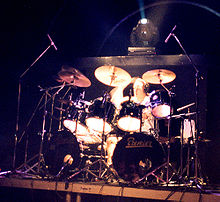Thomen Stauch
Thomen Stauch | |
|---|---|
 Stauch on Stage (2003) | |
| Background information | |
| Also known as | The Omen |
| Born | 11 March 1970 |
| Genres | |
| Occupation | Musician |
| Instrument | Drums |
| Years active | 1985–present |
Thomas "Thomen" Stauch (born 11 March 1970), also known by his nickname The Omen, is a German heavy metal drummer, mostly known as the co-founder and drummer of Blind Guardian. He played with the band from 1984 to 1986 and 1987 to 2005, claiming dissatisfaction with the direction the band had taken in its latter years. He had previously founded Savage Circus along with Piet Sielck in 2004 and worked in other projects such as Iron Savior and Serious Black.[1]
He began his career with Blind Guardian, playing drums on their 1985 demo, Symphonies of Doom. He remained with the band until April 2005,[citation needed] with his last release from the band being the live album Imaginations Through the Looking Glass, and his last studio album being the 2002 release, A Night at the Opera.
While still in Blind Guardian, he formed Savage Circus with friend Piet Sielck. Piet introduced him to Persuader vocalist Jens Carlsson and guitarist Emil Norberg, who completed the band's lineup. They released their debut album Dreamland Manor in August 2005. Due to health problems causing him to miss too many gigs, Thomen left the band on 17 August 2007 but came back to the line-up in 2012.[2]
Stauch joined the band Seelenzorn in September 2008.[3] He has also played drums for the band Coldseed with Soilwork frontman Björn Strid.
Stauch is known for his fast and technical drumming skill, especially on the Blind Guardian album A Night at the Opera, where he mixes the traditional intensity and speed of the band's older style, with new, more technical and progressive elements. He is a user of Premier Drums, Paiste cymbals and Vic Firth drumsticks.
References
- ^ "Thomen Stauch - Encyclopaedia Metallum: The Metal Archives". www.metal-archives.com. Retrieved 2018-08-17.
- ^ "Thomen Stauch official website". 2012-04-20. Retrieved 2013-02-20.
- ^ "Seelenzorn". Seelenzorn. 2008-09-19. Retrieved 2011-10-28.
